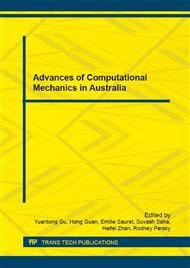p.366
p.372
p.378
p.385
p.391
p.397
p.403
p.409
p.415
Assessment of a Method to Model 2D Discontinuities with Enriched Finite Elements and Level Sets
Abstract:
The computational treatment of discontinuities within the framework of the finite element method (FEM) is a requirement for simulations of fracturing of solids and has become a challenging topic in computational mechanics. Particularly popular amongst the advanced schemes is the extended finite element method (XFEM) which is based on enrichment of shape functions and falls within the framework of the partition of unity method. Because there is no simple way to track the interface of discontinuities, the computer implementation of the XFEM is not as straightforward as the FEM. One method to solve the interface tracking problem is the level set method (LSM) which introduces another partial differential equation. The level set equation describes the change of an interface due to a known velocity field. To obtain its solution, the FEM can also be employed. This contribution investigates the XFEM-LSM technique with element enrichment and the integration of discontinuous elements for the modelling of cracks or material interfaces. Numerical experiments illustrate the capabilities and accuracy of the resulting formulation.
Info:
Periodical:
Pages:
391-396
Citation:
Online since:
July 2016
Authors:
Price:
Сopyright:
© 2016 Trans Tech Publications Ltd. All Rights Reserved
Share:
Citation:


